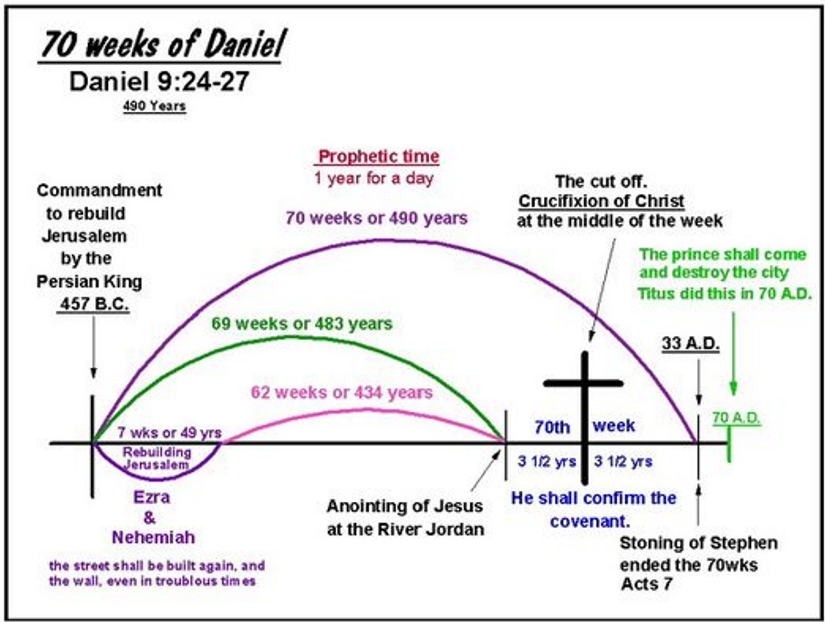The partial preterist interpretation of Daniel’s prophecy regarding the seventy weeks found in Daniel 9:24-27 is the most satisfying position for me and clearly reveals profound differences between it and futurist views. It more easily describes what happened historically without having to manipulate things by adding a two-thousand-year gap between the 69th and 70th weeks. This lesson will show that Daniel saw the rebuilding of Jerusalem, the coming of the Messiah, his crucifixion, and the subsequent destruction of the temple and Jerusalem. I will also incorporate into this discussion some of Jesus’ own prophecies about the end and show how they synchronize with Daniel.
God reveals important future events to us through prophecy in a way that almost defies analysis before they take place but makes sense after they happen. I believe one reason God does this is to help us navigate the present, not predict the future. When prophesied events take place, it confirms that God oversees history, and we are exactly where we are supposed to be.
When I first became a Christian in the early seventies, end time prophecy was all the rage. Most people adhered to a futurist pre-tribulation rapture kind of dispensationalism. Charts proliferated that showed how Russia would descend upon Israel leading up to Armageddon. There were popular books on the subject, such as The Late Great Planet Earth by Hal Lindsay. I had little understanding of church history at that time or of how earlier believers saw things. Over the years, as I learned more about alternative ways of looking at the end times, I was drawn toward the Amillennial view, thinking that it better reflects Jesus’ teachings. When I discovered the partial preterist viewpoint, which is well represented in the book Victorious Eschatology by Eberle and Trench, I felt right at home. Rather than changing my thinking, it stated clearly what I already believed.
Nevertheless, it is my firm conviction that it is wise to hold our positions regarding the end times rather loosely, understanding that we are all likely to be surprised by how things eventually play out.
The partial preterist interpretation of Daniel does not answer every question, but I feel it does capture the essence of what the prophet saw and explains why he was so devastated. He came away understanding that the Jews would reject their Messiah and that Jerusalem and the temple would be destroyed.
The discovery of Jeremiah’s written prophecies regarding seventy years of captivity preceded Daniel’s vision.
This whole land will be a desolation and a horror, and these nations will serve the king of Babylon seventy years. Jeremiah 25:11 (NASB95)
Let’s begin with the first three verses of Daniel Chapter 9.
In the first year of Darius the son of Ahasuerus, of Median descent, who was made king over the kingdom of the Chaldeans— 2 in the first year of his reign, I, Daniel, observed in the books the number of the years which was revealed as the word of the Lord to Jeremiah the prophet for the completion of the desolations of Jerusalem, namely, seventy years. 3 So I gave my attention to the Lord God to seek Him by prayer and supplications, with fasting, sackcloth and ashes. Daniel 9:1–3 (NASB95)
Daniel was deported to Babylon by Nebuchadnezzar in 605 BC. Jerusalem and the temple were destroyed in 586 BC. This vision was given in 539 BC, the first year of Cyrus’ rule, when the prophet was over 80 years old. In the same year, Cyrus decreed that Israel could return to their land. (Side note: Never think you are too old for God to use you.) Zerubbabel began work on the temple, and it was completed in 516 BC, seventy years after its destruction, thus fulfilling Jeremiah’s prophecy. In 457 BC, Artaxerxes gave Judah autonomy to establish Jerusalem as the capital of Israel. Many believe this event inaugurated the 70 weeks of Daniel, a 490-year period of favor for the Jews.
- 605 BC – Daniel deported
- 586 BC – Jerusalem and Temple destroyed
- 539 BC – Daniel’s Vision
- 516 BC – Completion of Second Temple (586-516 = 70 years)
- 457 BC – Artaxerxes granted Judah autonomy to make Jerusalem capital of Israel, apparently launching Daniel’s 70 weeks.
“Seventy weeks are determined For your people and for your holy city, To finish the transgression, To make an end of sins, To make reconciliation for iniquity, To bring in everlasting righteousness, To seal up vision and prophecy, And to anoint the Most Holy. 25 “Know therefore and understand, That from the going forth of the command To restore and build Jerusalem Until Messiah the Prince, There shall be seven weeks and sixty-two weeks; The street shall be built again, and the wall, Even in troublesome times. 26 “And after the sixty-two weeks Messiah shall be cut off, but not for Himself; And the people of the prince who is to come Shall destroy the city and the sanctuary. The end of it shall be with a flood, And till the end of the war desolations are determined. 27 Then he shall confirm a covenant with many for one week; But in the middle of the week He shall bring an end to sacrifice and offering. And on the wing of abominations shall be one who makes desolate, Even until the consummation, which is determined, Is poured out on the desolate.” Daniel 9:24–27 (NKJV)
A generally accepted convention for interpreting prophecy is making a day into a year. Below is a breakdown of how the partial preterist position interprets the 70 weeks.
- 7 weeks (49 years) – 457 BC (the decree of Artaxerxes to rebuild Jerusalem) to 408 BC, during which time were the ministries of Ezra (rebuilding the temple) and Nehemiah (rebuilding the wall of Jerusalem).
- 62 weeks (434 years ) – 408 BC to the baptism of Jesus in AD 27 (The anointing of the Holy One.) He was baptized and anointed with the Holy Spirit to carry out the work of the ministry.
- 1 week (7 years)
- AD 27 to AD 31: 3.5 years – The time from the beginning of Jesus’ ministry until the crucifixion. He is the the Anointed One who was cut off. The Messiah will be cut off, but not for himself, ending the need for any more animal sacrifices. He, the Messiah, shall confirm a covenant – the New Covenant.
- 31 AD to 34 AD: 3.5 years from the crucifixion to the stoning of Stephen, after which the door was officially opened to the Gentiles and a door of opportunity shut for the Jews.
- 70 AD: the destruction of the Temple by Titus and the Roman army (the people of the prince), effectively ending all animal sacrifices.
The preterist view does not put a 2000-year gap between the 69th and 70th week. Therefore, Daniel 9 does not predict what will happen at the very end of time just prior to the Second Coming.
We must get that from other places. Therefore, there will not be a rebuilding of the temple or the re-institution of animal sacrifices, unless it comes from Satan as an attempt to distract from the finished work of Christ.
Below is a chart that pictorially summarizes this teaching.

(The above chart provided by isabelshaw.z19.web.core.windows.net)
Gabriel provided Daniel with a precise time for the advent of the Messiah, AD 27, which is when Jesus turned 30 and inaugurated his public ministry by being baptized by John, his cousin. Many people believe that the Magi were descendants of disciples of Daniel who took his prophecy seriously and readily believed in the heavenly star which guided them to the Messiah.
Then after the sixty-two weeks the Messiah will be cut off and have nothing, and the people of the prince who is to come will destroy the city and the sanctuary. And its end will come with a flood; even to the end there will be war; desolations are determined. Daniel 9:26 (NASB95)
The above verse speaks of the Messiah being “cut off” or killed, which would be followed by “the people of the prince” (the Romans) destroying Jerusalem. Both futurists and partial preterists generally agree on this interpretation.
The 70th week is where the preterist interpretation is far simpler and more literal. The futurists insert a 2000-year (or so) gap here to account for what they call the “church age.” The presupposition is that the church is a kind of plan B which went into effect when the Jews rejected their Messiah. This presupposes that the biological Jewish people are the focus of God’s kingdom plans, not the church, to which I vehemently disagree. Partial preterists believe that there is no gap. Halfway into the seven-year period Jesus was crucified, fulfilling verse 27. (Futurists believe the seven-year period of the seventh week is the Great Tribulation.)
“And he will make a firm covenant with the many for one week, but in the middle of the week he will put a stop to sacrifice and grain offering; and on the wing of abominations will come one who makes desolate, even until a complete destruction, one that is decreed, is poured out on the one who makes desolate.” Daniel 9:27 (NASB95)
Instead of saying, as the futurist interpretation does, that the antichrist accomplishes these things, the context indicates that the Messiah will be the one who “will make a firm covenant with the many for one week, but in the middle of the week he will put a stop to sacrifice and grain offering.”
Jesus did this by offering himself as the Lamb of God and establishing the New Covenant, whereby he “finish[ed] the transgression, to make an end of sin, to make atonement for iniquity, to bring in everlasting righteousness…” (Dan. 9:24)
For by one offering He has perfected for all time those who are sanctified. 15 And the Holy Spirit also testifies to us; for after saying, 16 “This is the covenant that I will make with them After those days, says the Lord: I will put My laws upon their heart, And on their mind I will write them,” He then says, 17 “And their sins and their lawless deeds I will remember no more.” 18 Now where there is forgiveness of these things, there is no longer any offering for sin. Hebrews 10:14–18 (NASB95)
Verse 27 is extremely difficult even for Bible scholars to properly interpret; so, I will forego making any further comments on it.
Three and one-half years later was the end of this seven-year period of God’s favor toward the rebellious nation of Israel. Many think that the stoning of Stephen likely marked this end since he pronounced judgment upon the unbelieving Jews just before he was martyred.
You men who are stiff-necked and uncircumcised in heart and ears are always resisting the Holy Spirit; you are doing just as your fathers did. 52 “Which one of the prophets did your fathers not persecute? They killed those who had previously announced the coming of the Righteous One, whose betrayers and murderers you have now become; Acts 7:51–52 (NASB95)
After Stephen’s death, God commissioned both Peter and Paul to take the gospel to the Gentiles more aggressively. About 37 years later Jerusalem was destroyed and the temple obliterated.
One reason it is important for us to consider the partial preterist point of view is because it allows us to think of the end times in an entirely different way from the futurist position. Instead of expecting a restoration of glorified state of Israel what will rule over the nations complete with a functioning temple before Jesus returns, we understand that nothing must happen before his return and that the church is the Israel of God, which includes both Jew and Gentile. He could come at any time, which is precisely what Jesus taught on repeated occasions.
“You too, be ready; for the Son of Man is coming at an hour that you do not expect.” Luke 12:40 (NASB95)
The originator of modern dispensational theology, which elevates Israel in this way, is generally recognized as John Nelson Darby, who co-founded the Plymouth Brethren. Cyrus Scofield popularized the secret rapture and dispensationalism. He was convicted of political corruption and spent some time in jail for forging checks. He also abandoned his first wife and two children. He seems to have had ties with the Masons as well. All this makes me question the origin of this doctrine.
The reinstatement of the Jewish nation state in 1948 was orchestrated by the Rothschilds (Illuminati) and supported wholeheartedly by Christians who had adopted the questionable futurist dispensational view that predicts that the nation of Israel would be restored to world prominence in the end times. Could it be that we have improperly elevated the nation state of Israel thus overlooking the basic wickedness of its people, who continue to reject their Messiah king?
For it is written that Abraham had two sons, one by the bondwoman and one by the free woman. 23 But the son by the bondwoman was born according to the flesh, and the son by the free woman through the promise. 24 This is allegorically speaking, for these women are two covenants: one proceeding from Mount Sinai bearing children who are to be slaves; she is Hagar. 25 Now this Hagar is Mount Sinai in Arabia and corresponds to the present Jerusalem, for she is in slavery with her children. 26 But the Jerusalem above is free; she is our mother. 27 For it is written, “Rejoice, barren woman who does not bear; Break forth and shout, you who are not in labor; For more numerous are the children of the desolate Than of the one who has a husband.” 28 And you brethren, like Isaac, are children of promise. Galatians 4:22–28 (NASB95)
It does seem that God has something special in store for those physical descendants of Abraham who reside in the Jerusalem area at the time of the second coming of Christ, according to prophecy.
And in that day I will set about to destroy all the nations that come against Jerusalem. 10 “I will pour out on the house of David and on the inhabitants of Jerusalem, the Spirit of grace and of supplication, so that they will look on Me whom they have pierced; and they will mourn for Him, as one mourns for an only son, and they will weep bitterly over Him like the bitter weeping over a firstborn. Zechariah 12:9–10 (NASB95)
But this revelation of Christ will mean that those receiving it will be born again. Paul taught that the true Israel of God are all those who are born of the Spirit, both Jew and Gentile, who have become one body of Christ.
For you are all sons of God through faith in Christ Jesus. 27 For all of you who were baptized into Christ have clothed yourselves with Christ. 28 There is neither Jew nor Greek, there is neither slave nor free man, there is neither male nor female; for you are all one in Christ Jesus. 29 And if you belong to Christ, then you are Abraham’s descendants, heirs according to promise. Galatians 3:26–29 (NASB95)
If we place undue emphasis upon the nation state of Israel, it may influence us to overlook their part in Satan’s schemes. It is noteworthy that Ghislane Maxwell, Jeffrey Epstein’s companion, was the daughter of a Mossad agent, and that Israel pushed the mRNA jab more than any other nation. It could be that the Israeli nation state is the head of the serpent from which Christ will redeem a remnant at the very end. In no way does this justify antisemitism. However, we must not fall into the error of glorifying the natural descendants of Abraham either. We should pray for the peace of Jerusalem and the salvation of the Jewish people.
The partial preterist viewpoint frees us up to understand Daniel’s seventy weeks in a way makes sense historically and prepares us for the imminent return of our Lord. It teaches us to carefully consider how some prophecies have been already fulfilled in many cases, instead of assuming their fulfillment is all in the future. It does not explain everything, but neither do other interpretations. God keeps some things hidden so that we will need to trust in him instead of leaning on our own understanding.


